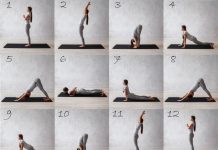In Sanskrit, mudra means to seal or close. The use of mudra in yoga is designed to direct energy flows in the body with use of the hands. The brain and certain body parts are connected to different parts of the hands, so when the hands are placed in certain mudras, the effects can stimulate the brain and help create energy that helps create a specific state of mind pertaining to the main focus of your yoga or meditation purposes.
Shuni Mudra
The shuni mudra is known as the seal of patience and represents discipline and patience and helps to increase the feeling of stability and steadiness within the mind and body. It also enables a greater connection of compassion towards others and minimizes negative emotions of the practitioner.
To perform the shuni mudra, gently touch the thumb to the middle finger and slowly release the three remaining fingers.
Buddhi Mudra
The Buddhi mudra is known as the seal of perception and represents communication and openness. The buddhi mudra focuses on the water within the body and brings together the elements of fire and water strengthening intuition and knowledge. To perform the Buddhi mudra, gently touch the thumb to the little finger and slowly release the three remaining fingers.
Surya Ravi Mudra
The Surya Ravi mudra represents energy and health. The buddhi mudra focuses on the water within the body and brings together the elements of fire and earth, strengthening positive feelings and creating a sense of balance within life. To perform the Surya Ravi mudra, gently touch the thumb to the tip of the ring finger and slowly release the three remaining fingers.
Gyana Mudra
The Gyana mudra is possibly the most well-known mudra in yoga and is commonplace around the world. The gyana mudra helps increase creativity and concentration and is also perceived as being knowledgeable. The Gyana mudra focuses on the unity of fire and air and symbolizes unity both on a personal and universal level. To perform the Gyana mudra, gently touch the thumb to the index finger and keep the three remaining fingers together with the palm facing upwards.
Dhyana Mudra
The Dhyana mudra is known as the seal of calmness and represents a method for gaining deep spiritual contemplation. By performing the Dhyana mudra, the practitioner can gain a dedicated concentration for meditation and serenity.
To perform the Dhyana mudra, take your hands with their palms facing up and place the left one on top of the right one and put in your lap. The tips of the thumbs should be touching and the palms will create a bowl effect.
Anjali Mudra
The Anjali mudra represents honor and respect not only to oneself but to the entire universe and all that is in it. The Anjali mudra also shows a high level of respect and love and gratitude to both human and non-human lifeforms.
To perform the Buddhi mudra, gently place the hands together in a prayer-like motion in front of the area where the heart is located. The arms should be horizontal and elbow level with the heart line.
47 Most Famous Motivational Quotes of All-Time
49 Greatest Love Quotes
37 Inspirational Quotes that Will Change Your Life






























